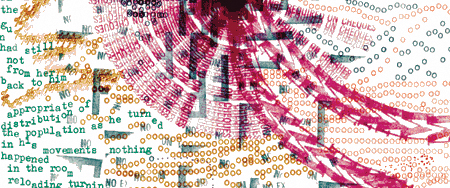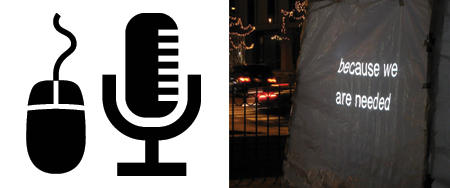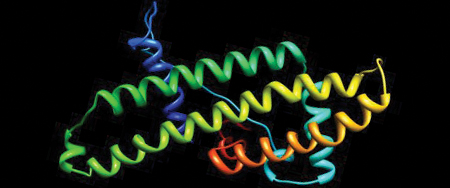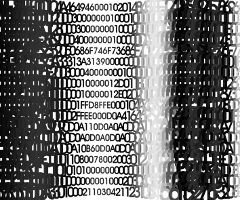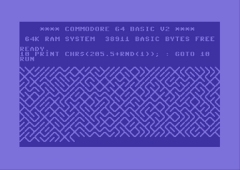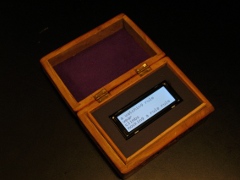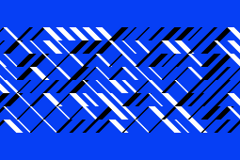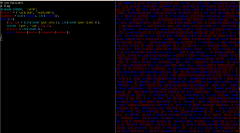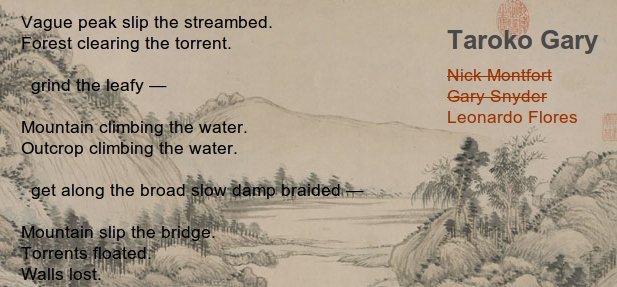Marty Markowitz, borough president of Brooklyn, said his borough was “the heart of America” in welcoming the 35th Annual American Crossword Puzzle Tournament. My heart was certainly in Brooklyn last weekend, both literally and figuratively. I was there to participate in the First Annual World Palindrome Championship on Friday and, on Saturday, to visit Big Reality, a wonderful, scruffy art show that included some of my work. More on Big Reality soon; here’s a belated note about the WPC.
I made into New York in time to meet at Jon Agee’s sister’s house in Brooklyn with him and several other palindromists who would be competing that evening. (Agee is a cartoonist whose books include Go Hang a Salami! I’m a Lasagna Hog! and Palindromania!) The other competitors included a fellow academic, John Connett, who is professor of Biostatistics at the University of Minnesota and an extremely prolific producer of sentence-length palindromes. Martin Clear, another author of many, many sentence-length palindromes, came from Australia. Barry Duncan, a Somerville resident and thus practically my neighbor, also joined us. Another competitor was Mark Saltveit, editor of The Palindromist and a stand-up comedian. And Douglas Fink, who won a celebrity palindrome contest with his now-famous entry “Lisa Bonet ate no basil,” was the audience contestant selected to join us.
I met Barry and Doug later that day, and had a great time sitting around and discussing palindromes with the others over lunch. We had plenty to talk about. It was interesting to see that we also had different perspectives, interests, and terms associated with the art. Jon thought “Er, eh – where?” was a good palindrome, probably in part because he was imagining how to illustrate it or frame it in a cartoon in a funny way. The others generally thought this one was bogus. A sentence was the desired outcome for most of us, while I was a fan (and writer) of longer palindromes. And, as we found out that night, the audience had their own tropisms and aesthetics when it comes to palindromes.
We had 75 minutes to write up to three palindromes that we’d read to the crowd, which was to vote for their two favorite. There were three possible constraints given: Use X and Z; Refer to events in the news in the past year; or refer to the crossword tournament itself. Here’s what I came up with, using the first constraint:
The Millennium Falcon Rescue
by Nick Montfort
Wow, sagas … Solo’s deed, civic deed.
Eye dewed, a doom-mood.
A pop.
Sis sees redder rotator.
Radar sees racecar X.
Oho! Ore-zero level sees reviver!
Solo’s deified!
Solo’s reviver sees level: ore-zero.
Oho: X, racecar, sees radar.
Rotator, redder, sees sis.
Pop a doom-mood!
A dewed eye.
Deed, civic deed.
Solo’s sagas: wow.
All of the results (and the text of the palindromes) are up on The Palindromist site – take a look!
Mark Saltveit became champ with a short palindrome about acrobatic Yak sex. John Connett got 2nd, Jon Agee 3rd, and yours truly 4th.
Which is the longest?
In mine, I count 54 words, 237 letters, and 327 characters. If “doom-mood” and the like are single words, we’d have 50 words. Mark says on The Palindromist site that it’s 57 words long; I’m not sure how the counting was done there.
In Barry’s, the only other possible contender, I count 70 words (as does Mark), 184 letters, and 311 characters. Some of those words are “7” and have no letters in them, as you’ll note if you check out the results page.
So, they’re both the longest: Barry’s has the most words, while mine has the most letters and characters.
It’s a sort of odd comparison, because the constraint I used (employ only palindromic words, counting things like “ore-zero” as words) let me reframe the problem as that of constructing a word palindrome with a restricted vocabulary. Of course, you should be very very impressed anyway, with my general cleverness and so on, but I think Barry chose a more difficult feat at the level of letter-by-letter construction.
Does length matter?
Yes. A palindrome should be the right length. 2002 words is a good length if you’re trying to write a palindromic postmodern novel. For a snappy statement, a short sentence is a good length. I think some of the best palindromes are longer than a sentence and much shorter than 2002. My last edits to “The Millennium Falcon Rescue” were to cut several words (an even number, of course), and maybe I should have cut more? And, should I revise this one, I might cut the word that was included for the sake of the Z.
What about those palindromists?
The most interesting thing about this event, for me, was a gathering focused on palindrome-writing. Kids know what palindromes are, the form of writing has been around for more than a thousand years, many people have palindromes memorized, and there are a handful of famous books … but as I see it there hasn’t even been a community of palindrome-writers, discussing writing methods, coming up with common terms and concepts, sharing poetic and aesthetic ideas.
Well, perhaps there has been, in the Bletchley Park codebreakers. But I only learned about them because I met Mark, who is one of the people researching the origins of famous palindromes. And that was, due to wartime security, a very secretive group.
It was great having the Championship hosted by Will Shortz at the American Crossword Puzzle Tournament, with many puzzle-solver and -constructors who are interested in formal engagements with language. Of course, palindrome events would fit will at other sorts of gatherings that are focused on poetry and writing, too.
Whether or not we have another championship (which would be great), it would be nice to have another summit of some sort and to build a community of practice around this longstanding practice. Particularly if we can get someone named Tim to join us: Tim must summit!



